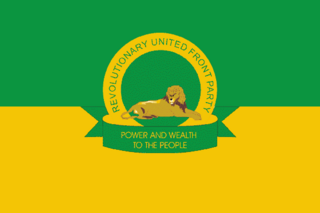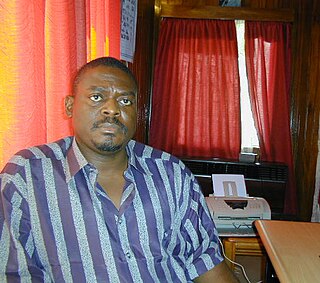Sierra Leone first became inhabited by indigenous African peoples at least 2,500 years ago. The Limba were the first tribe known to inhabit Sierra Leone. The dense tropical rainforest partially isolated the region from other West African cultures, and it became a refuge for peoples escaping violence and jihads. Sierra Leone was named by Portuguese explorer Pedro de Sintra, who mapped the region in 1462. The Freetown estuary provided a good natural harbour for ships to shelter and replenish drinking water, and gained more international attention as coastal and trans-Atlantic trade supplanted trans-Saharan trade.

The Republic of Sierra Leone Armed Forces are the armed forces of Sierra Leone, responsible for the territorial security of Sierra Leone's borders and defending the national interests of Sierra Leone, within the framework of the 1991 Sierra Leone Constitution and International laws. The armed forces were formed after independence in 1961, on the basis of elements of the former British Royal West African Frontier Force, then present in the Sierra Leone Colony and Protectorate.

The Revolutionary United Front (RUF) was a rebel group that fought a failed eleven-year war in Sierra Leone, beginning in 1991 and ending in 2002. It later transformed into a political party, which still exists today. The three most senior surviving leaders, Issa Sesay, Morris Kallon and Augustine Gbao, were convicted in February 2009 of war crimes and crimes against humanity.

Alhaji Ahmad Tejan Kabbah was a Sierra Leonean politician who served twice as the 3rd President of Sierra Leone, from 1996 to 1997 and again from 1998 to 2007. An economist and attorney by profession, Kabbah spent many years working for the United Nations Development Programme. He retired from the United Nations and returned to Sierra Leone in 1992.

Major Johnny Paul Koroma was a Sierra Leonean military officer who was the head of state of Sierra Leone from May 1997 to February 1998.

The United Nations Mission in Sierra Leone (UNAMSIL) was a United Nations peacekeeping operation in Sierra Leone from 1999 to 2006. It was created by the United Nations Security Council in October 1999 to help with the implementation of the Lomé Peace Accord, an agreement intended to end the Sierra Leonean civil war. UNAMSIL expanded in size several times in 2000 and 2001. It concluded its mandate at the end of 2005, the Security Council having declared that its mission was complete.
The Armed Forces Revolutionary Council (AFRC) was a group of Sierra Leone soldiers that allied itself with the rebel Revolutionary United Front in the late 1990s. While the AFRC briefly controlled the country in 1998, it was driven from the capital by an international military intervention of the Economic Community of West African States Monitoring Group (ECOMOG). It was no longer a coherent and effective organization by the elections of 2002.
The Sierra Leone Civil War (1991–2002), or the Sierra Leonean Civil War, was a civil war in Sierra Leone that began on 23 March 1991 when the Revolutionary United Front (RUF), with support from the special forces of Liberian dictator Charles Taylor's National Patriotic Front of Liberia (NPFL), intervened in Sierra Leone in an attempt to overthrow the Joseph Momoh government. The resulting civil war lasted 11 years, enveloping the country. It left over 50,000 dead.
Samuel Hinga Norman was a Sierra Leonean politician from the Mende tribe. He was the founder and leader of the Civil Defence Forces, commonly known as the Kamajors. The Kamajors supported the government of Ahmed Tejan Kabbah against the Revolutionary United Front(RUF), which was led by Foday Sankoh. On 7 March 2003 Hinga Norman was indicted by the Special Court for Sierra Leone for war crimes and crimes against humanity. He died on 22 February 2007 in Dakar, Senegal while undergoing medical treatment.
The Kamajors were a group of traditional hunters from the Mende ethnic group in the south and east of Sierra Leone. The word "Kamajor" derived from Mende "kama soh", meaning traditional hunter with mystical powers, who were originally employed by local chiefs.
The Lomé Peace Agreement was a peace agreement signed on 7 July 1999 between the warring parties in the civil war that gripped Sierra Leone for almost a decade. President Ahmad Tejan Kabbah signed with the Revolutionary United Front (RUF) leader, Foday Sankoh and granted Sankoh a position in the transitional government as well as amnesty for him and all combatants. The accord is named for Lomé, the capital of Togo, where the negotiations took place and the agreement was signed.
Samuel Sam Bockarie, widely known as Mosquito, was a Sierra Leonean politician and army commander who served as a leader of the Revolutionary United Front (RUF). Bockarie was infamous during the Sierra Leone Civil War for his brutal tactics, which included amputation, mutilation, and rape. He earned the nickname "Mosquito" for his ability to attack when his enemies were off-guard, mainly during the night. During his service in the RUF, he befriended future Liberian president Charles Taylor, and RUF commander Foday Sankoh. When Sankoh was imprisoned from March 1997 until April 1999, Bockarie served as commander of the RUF in his place.
The Abidjan Peace Accord was a treaty signed in Abidjan, Côte d'Ivoire on 30 November 1996 to try to bring an end to the Sierra Leone Civil War (1991–2002). The two main signatories were President Ahmad Tejan Kabbah of Sierra Leone and Foday Sankoh, leader of the Revolutionary United Front (RUF) rebel group. However, Sankoh refused to honour the terms of the agreement, and Kabbah was forced into exile by a May 1997 military coup, so the Accord failed to bring about peace.

Charles Francis Kondo Margai is a Sierra Leonean politician and constitutional lawyer who served as Attorney General and Minister of Justice of Sierra Leone in 2018.
Solomon Ekuma Dominic Berewa was Vice-president of Sierra Leone from May 2002 to September 2007. Standing as the candidate of the Sierra Leone People's Party (SLPP), he was defeated in the second round of the 2007 presidential election by Ernest Bai Koroma of the All People's Congress (APC).
The Civil Defense Forces (CDF) was a paramilitary organization that fought in the Sierra Leone Civil War (1991–2002). It supported the elected government of Ahmed Tejan Kabbah against the rebel groups Revolutionary United Front (RUF) and Armed Forces Revolutionary Council (AFRC). Much of the CDF was made up of the Kamajors group, which is part of the larger Mende ethnic group. The Kamajors believed in many magical ways of defending themselves, such as rituals to create bulletproof skin.

Ernest Bai Koroma is a Sierra Leonean politician who served as the fourth President of Sierra Leone from 17 September 2007 to 4 April 2018.
Peter Alfred Penfold was a British diplomat who was the youngest governor of the British Virgin Islands and was High Commissioner to the Republic of Sierra Leone. His career began in 1963, when he joined the Foreign Service as a clerical officer. Two years into his career, he was posted to the British embassy in Bonn, West Germany, and two years after that to Nigeria. From 1970 to 1972, Penfold served as a "floater" in Latin America, filling in as necessary for staff at British missions in the region. He served in Mexico during the 1970 football world cup, and on St Vincent, where he was responsible for organising an evacuation after a volcanic eruption. After Latin America, Penfold briefly served in Canberra, before returning to London to take a post in the Foreign and Commonwealth Office (FCO). He earned early promotion to second secretary in Addis Ababa, Ethiopia, where he was responsible for reporting on the Organisation of African Unity (OAU) and the Eritrean War of Independence and was still in the country during the revolution, in which the pro-Western emperor was overthrown. After completing his tour in Ethiopia, Penfold served as information officer in Port of Spain and then as first secretary in the West Africa Department of the FCO.

The United Nations Observer Mission in Sierra Leone (UNOMSIL) was a United Nations peacekeeping operation in Sierra Leone from 1998 to 1999 that was established with the passage of United Nations Security Council Resolution 1181. Its mission was to monitor the military and security situation in Sierra Leone. The mission was terminated in October 1999, when the Security Council authorized deployment of a new, and significantly larger peacekeeping operation, the United Nations Mission in Sierra Leone (UNAMSIL).







